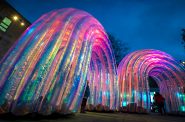Impressionism’s intimate expression
Most of the artists are familiar – Monet, Degas, Cassatt, Cezanne, Pissaro, Renoir, Seurat, Gauguin, Van Gogh, Cezanne, and Toulouse-Lautrec – but not all of them. My new favorite Impressionist is Jean-Louis Forain. His The Client, a small watercolor and gouache, shimmers with high contrast strokes of color (and crackles with charged subject matter).
Lloyd discussed the premise of this exhibition as we walked through the rooms of drawings, watercolors, and pastels. The curators invite viewers to witness the birth of 20th century modern art. Impressionist and Post Impressionist artists learned traditional drawing and painting techniques, but began to see drawing as a way to better express the new world they were experiencing. The Industrial Revolution and advances in science were changing the world at an ever increasingly rapid rate. How to express that? With traditional easel paintings that took months to complete? Art bearing witness to its time is often at odds with the establishment, and so it was with Impressionism.
The official French Academy maintained a strong hold on the art permitted in their Salon exhibitions, culled according to a long tradition of correct subject matter and technique. Traditional painting ruled and excluded the avant-garde. The Impressionists were the first group of French artists to organize and promote their own alternative exhibitions.

Toulouse-Lautrec, Trapeze Artist at the Medrano Circus, 1887-1888. Harvard Art Museum/Fogg Art Museum.
To much scorn from the Academy, these artists developed their own visual vocabulary and proudly exhibited and sold works on paper along with their cutting edge paintings. Drawings made up an astounding 40% of the artworks in the eight Impressionist Exhibitions, held between 1874 and 1886.
Drawing is intentional, fast, experimental. Drawing is personal and immediate. The artist’s marks can be as identifiable as a signature. Impressionist artists saw their expressive drawings as important and serious works of art in their own right, not mere studies for a painting (although many were versions of paintings). This was a brand new argument for a brand new world in the making. Up to this point, drawings were considered preliminary work of little intrinsic value.
In this exhibition, many of the spaces between figures point toward Monet’s late Water Lilies and beyond, to Rothko, Pollock and Abstract Expressionism, which came to dominate the mid 20th century 60 or so years later. These drawings influenced 20th century artists as they created the canon of Modern Art.
The thoughtful, intentional layout of MAM’s Impressionist show takes us from the 1860 pastels landscapes of Eugene Boudin, known for his beautiful but traditional paintings, on a quiet and profound trip through time to works created in the 1890s by Henri Toulouse-Lautrec. “Here,” Lloyd pronounced, “painting IS drawing.”
The journey in between yields treasure after treasure and opens to us the artists’ personal, immediate worlds. Lloyd called the first room in the exhibition a microcosm of the thesis. He described Boudin’s “pithy” pencil and watercolor drawings as “clothing pegged out on a washing line.” Boudin’s drawings hang beside Monet’s pastels, and the influence is clear. Monet drew on site, and we feel the gesture of his hand, see his decision-making process.
Where the sky meets the horizon in a Degas seascape, I could see a see a Rothko painting. Lloyd shot back: “Exactly!”
Edgar Degas holds a central place here. His pastel drawings of women privately bathing are icons of Impressionism. Lloyd quoted Degas as claiming to “plan a composition as if it were a crime.” By this he means attention to all the details down to the last mark. While Degas called these pastels a “keyhole” view of the private scene, he never meant voyeurism. He wanted to capture a moment that no one sees, one that resonates with us all. Degas’ pastels are equal to paintings. He knew and used traditional pastel techniques, but then challenges viewers with the overall illusion and abstract details. He layered colors, juxtaposed complementary colors, and used color itself as a key part of the overall composition.
His friend, Mary Cassatt, the only American in the exhibition, focuses on different subject matter. One of her favorites is the quiet moment between mother and young child. She too composes with color as a prime element.
The show extends a rare and welcome chance to view drawings by Van Gogh. The marks, the color and the meaning intertwine in his works on paper. I especially love an early pen and ink Cemetery in the Rain, rendered with a delicacy we don’t associate with Van Gogh. When paired with Window in the Studio at Saint-Remy, drawn while he was in an asylum, we see in two legs in his troubled journey through life. The bright ochre room, adorned with his own paintings is juxtaposed with the arched window and the view of trees. Unease takes hold when we see the bars on the window, at once the reality and the perfect metaphor of his illness.
We know Seurat for his Pointillist paintings, which are nearly scientific experiments in color theory and how we see color and light. His drawings show a technique he developed using conti crayons on handmade paper with a lightly textured surface. His light pressure with the crayon covers the top surface of the textured paper and leaves flecks of the light showing through the black. The mostly dark images hold their own as high works of art. The paintings teach us about seeing color; Seurat’s conti drawings teach us to see form through light and shadow.
Impressionism: Masterworks on Paper is a scholarly, and rewarding, exhibition that requires time to view and think in order to thoroughly grasp Christopher Lloyd and Laurie Winter’s vision. Lloyd wrote the excellent catalog. Impressionism is on view at the Milwaukee Art Museum through Jan. 8.
Art
-
Winning Artists Works on Display
 May 30th, 2024 by Annie Raab
May 30th, 2024 by Annie Raab
-
5 Huge Rainbow Arcs Coming To Downtown
 Apr 29th, 2024 by Jeramey Jannene
Apr 29th, 2024 by Jeramey Jannene
-
Exhibit Tells Story of Vietnam War Resistors in the Military
 Mar 29th, 2024 by Bill Christofferson
Mar 29th, 2024 by Bill Christofferson

























